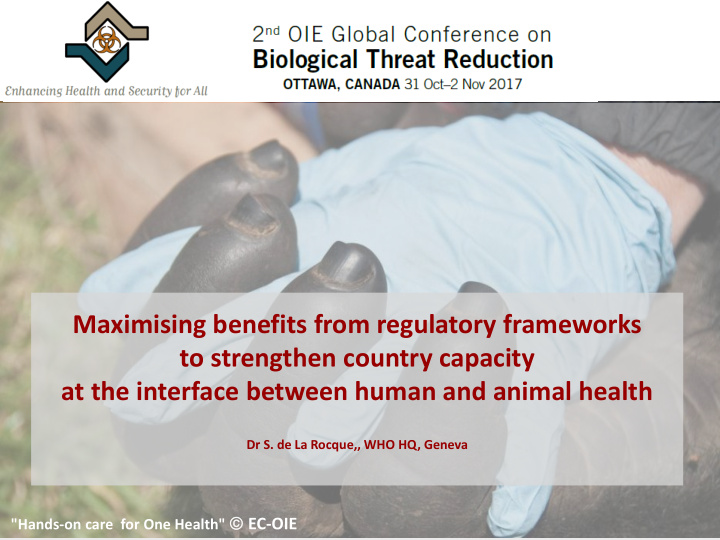



Maximising benefits from regulatory frameworks to strengthen country capacity at the interface between human and animal health Dr S. de La Rocque,, WHO HQ, Geneva "Hands-on care for One Health" EC-OIE
International Committee of Military Forces
80% of agents with potential bioterrorist use are zoonotic pathogens Of known human diseases originated in animals Of recent emerging infectious diseases are zoonotic
RVF, White Nile, Sudan, 2007 – Joint investigation
RVF, another country, 2007 – Joint investigation
Purpose of the IHR (2005) " to prevent, protect against, control and provide a public health response to the international spread of disease in ways that are commensurate with and restricted to public health risks, and which avoid unnecessary interference with international traffic and trade " IHR (2005), article 2
Purpose of the IHR (2005) “Each State Party shall develop , strengthen and maintain, as soon as possible (…), the capacity to detect, assess, notify and report events in accordance with these Regulations… and ... the capacity to respond promptly and effectively…" IHR (2005), articles 5 and 13
IHR Monitoring and Evaluation Framework (2016) Recommendations from the IHR Review Committee (2014) “… combine self-evaluation, peer review and voluntary external evaluations involving a combination of domestic and independent experts.”
IHR Monitoring and Evaluation Framework (2016) Self-Assessment & Recommendations from the IHR Reporting Review Committee (2014) IHR-MEF “… combine self-evaluation, peer review and voluntary external evaluations involving a combination of domestic and independent experts.”
IHR Monitoring and Evaluation Framework (2016) Self-Assessment & Recommendations from the IHR Reporting Review Committee (2014) IHR-MEF External Evaluation “… combine self-evaluation, peer review and voluntary external evaluations involving a combination of domestic and independent experts.”
IHR Monitoring and Evaluation Framework (2016) Self-Assessment & Recommendations from the IHR Reporting Review Committee (2014) IHR-MEF External Evaluation “… combine self-evaluation, peer review and voluntary external evaluations involving a combination of After-Action Review domestic and independent experts.” Simulation Exercises
Self-Assessment & Reporting IHR-MEF External Evaluation After-Action Review Simulation Exercises
Self-Assessment & Reporting One Health IHR-MEF External Evaluation Human After-Action Review Env . Animal Simulation Exercises
Self-Assessment & Reporting One Health IHR-MEF External Evaluation Human After-Action Review Env . Animal Simulation Exercises National Action Plans
Self-Assessment & Reporting One Health IHR-MEF External Evaluation Human After-Action Review Env . Animal Simulation Exercises National Action Plans Increase in capacities for IHR
As of 1st November 2017
Contribution of the veterinary sector in the JEE None Minor Significant Major 19. Radiation Emergencies 18. Chemical Events 17. Points of Entry (PoE) 16. Risk Communication 15. Medical Countermeasures & Personnel Deployment 14. Linking Public Health & Security Authorities 13. Emergency Response Operations 12. Preparedness 11. Workforce Development 10. Reporting 9. Real Time Surveillance 8. National Laboratory System 7. Immunization 6. Biosafety and Biosecurity 5. Food Safety 4. Zoonotic Disease 3. Antimicrobial Resistance (AMR) 2. IHR Coordination, Communication & Advocacy 1. National Legislation, Policy & Financing 0.0 0.5 1.0 1.5 2.0 2.5 3.0
Contribution of the veterinary sector in the JEE 19. Radiation Emergencies 18. Chemical Events 17. Points of Entry (PoE) 16. Risk Communication 15. Medical Countermeasures & Personnel Deployment 14. Linking Public Health & Security Authorities 13. Emergency Response Operations 12. Preparedness 11. Workforce Development 10. Reporting 9. Real Time Surveillance 8. National Laboratory System 7. Immunization 6. Biosafety and Biosecurity 5. Food Safety 4. Zoonotic Disease 3. Antimicrobial Resistance (AMR) 2. IHR Coordination, Communication & Advocacy 1. National Legislation, Policy & Financing 0.0 0.5 1.0 1.5 2.0 2.5 3.0
The OIE PVS Pathway Performance of Veterinary Services
PVS pathway Inform on countries capacities in the implementation of the IHR (2005)
How can we use this unique source of information during JEE missions?
Indicator in the JEET – RESPONSE 5: RISK COMMUNICATION R.5.2 Internal and Partner Communication and Coordination PVS Critical Description Competency III-1. Communication This CC reviews the capability of the VS to keep interested parties informed ... inter alia : - Formal procedures and mechanisms.. - Communication tools… II-6. Emergency This CC reviews the authority and response capability of the VS to response rapidly … inter alia : -pre-established communication procedures… -Simulation exercises. Contributions of the Veterinary Services in 35 indicators of 16 JEET technical areas
Indicator in the JEET – RESPONSE 5: RISK COMMUNICATION R.5.2 Internal and Partner Communication and Coordination PVS Critical Description Competency III-1. Communication This CC reviews the capability of the VS to keep interested parties informed ... inter alia : - Formal procedures and mechanisms.. - Communication tools… II-6. Emergency This CC reviews the authority and response capability of the VS to response rapidly … inter alia : -pre-established communication procedures… -Simulation exercises. WWW.bit.ly/HandbookJEEPVS
The IHR-PVS National Bridging Workshops
The IHR-PVS National Bridging Workshops
These activities are developed by a team of colleagues and friends, mainly F. Caya , E. Tagliaro & S. Corning (OIE), R. Sreedharan & G. Belot (WHO). We are very grateful to our partners: "Hands-on care for One Health" EC-OIE
Recommend
More recommend